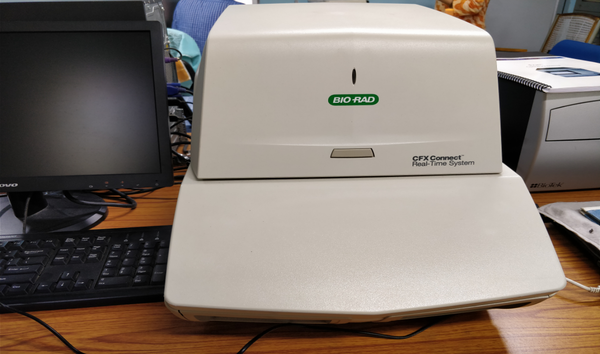


Quantitative PCR
Working principles (With illustration)
The instrument Real-Time PCR, also known as quantitative polymerase chain reaction (qPCR) runs on the principles of polymerase chain reaction (PCR) where amount of product amplified during each cycle is linked to fluorescence intensity using a non-specific fluorescent reporter, SYBR green molecule for detection and quantitative measurement. A threshold level of fluorescence is set above the background within the linear phase of amplification for all the plots. The cycle number at which an amplification plot crosses the threshold fluorescence level is called the “Ct” or threshold cycle. The Ct value can be directly correlated to the starting target concentration of the sample. The greater the amount of initial DNA template in the sample, the earlier the Ct value for that sample. All C t data were transported to MS-Excel for further processing and final result was represented as normalized expression (2 -ΔCt ) or comparative expression (2 -ΔΔCt ).
Application and studies related to
User Instruction (how to bring samples)
User name:
Dr. Md. AftabuddinInstrument Details:
Make
BIO-RADModel:
CFX Connect Real-Time systemTemperature Range::
30–100°CMaximum heating rate:
5°C/sec (Maximum)Maximum cooling rate:
5°C/sec (Maximum)Other Details:
CFX Connect optical reaction module excite fluorophores (SYBR®Green I, FAM etc.) by 3 filtered LEDs (450–535 nm) and detect emission by 3 photodiodes (515–580 nm) with the sensitivity of 1 copy. Excites and detects fluorophores in three channels and uses multiple data acquisition scan modes to collect fluorescence data during a run.CFX Manager software to calculate end data.Current Status of Instrument:
Working conditionCharges including GST
Name of Analysis Price per gene (in ₹)) Remarks PCR quantification of gene (2 samples) 6000 (Industry / Enterpreneur)
3500 (Research/Academic/Farmer)
Nil PCR quantification of gene (10 samples) 10000 (Industry / Enterpreneur)
6000 (Research/Academic/Farmer)
Nil Contact details with e-mail & phone:
- Dr. Md. Aftabuddin
B.V.Sc.& AH (BCKV), M.Sc.( Dairying) NDRI), Ph. D.(IVRI)
ARS, Biochemistry (Animal Science)
Principal Scientist
Reservoir and Wetland Fisheries Division
ICAR-Central Inland Fisheries Research Institute
Barrackpore, Kolkata-700120, W.B.
Mobile:9674410154 email:mdaftab73@rediffmail.com
